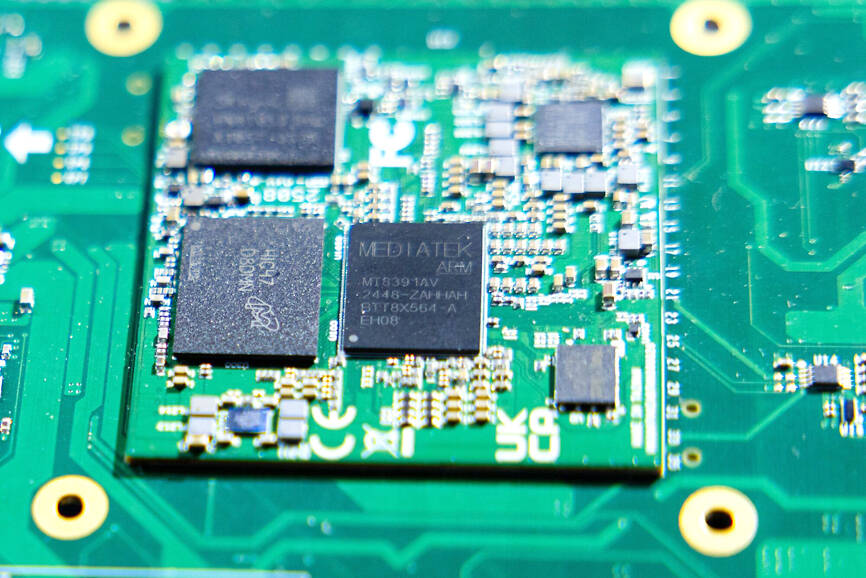Several Taiwanese semiconductor suppliers are taking a cautious view of the third quarter — typically a peak season for the industry — citing uncertainty over US tariffs and the stronger New Taiwan dollar.
Smartphone chip designer MediaTek Inc (聯發科技) said that customers accelerated orders in the first half of the year to avoid potential tariffs threatened by US President Donald Trump’s administration. As a result, it anticipates weaker-than-usual peak-season demand in the third quarter.
The US tariff plan, announced on April 2, initially proposed a 32 percent duty on Taiwanese goods. Its implementation was postponed by 90 days to July 9, then further delayed to Aug. 1 to allow for negotiations. Taiwan’s tariff rate was ultimately set at 20 percent, effective on Friday last week.

Photo: Annabelle Chih, Bloomberg
In April, the US also launched an investigation into potential tariffs on semiconductor imports. On Wednesday, Trump said a tariff of about 100 percent could be imposed on imported semiconductors, with exemptions for manufacturers building plants in the US.
Echoing MediaTek’s outlook, sensor chip designer PixArt Imaging Inc (原相科技) said customers producing computer mice front-loaded large orders in the first half, but demand is likely to slow in the third quarter.
Display driver chip designer Novatek Microelectronics Corp (聯詠科技) also said that customers have become cautious about new orders after aggressive purchases earlier this year.
The appreciation of the NT dollar is another headwind. The local currency rose 10.97 percent against the US dollar in the second quarter, ending June at NT$29.902, which led to foreign exchange losses for several firms.
For example, application-specific chip designer Progate Group Corp (巨有科技) posted a second-quarter net loss of NT$0.06 per share.
Although the NT dollar has weakened slightly since the start of the third quarter, the industry still expects the average exchange rate to remain stronger than in the previous quarter, which could continue to weigh on operations.
MediaTek forecasts third-quarter revenue to fall 7 to 13 percent from the previous quarter, to between NT$130.1 billion and NT$140 billion (US$4.36 billion and US$4.68 billion).
By contrast, contract chipmaker Taiwan Semiconductor Manufacturing Co (TSMC, 台積電) expects strong demand for artificial intelligence applications to drive an 8 percent quarter-on-quarter revenue increase in US dollar terms, based on an exchange rate of NT$29 to the greenback.
For the full year, TSMC projects revenue growth of 30 percent in US dollar terms, outpacing the global semiconductor industry’s estimated 15.4 percent expansion.

Taiwan Semiconductor Manufacturing Co (TSMC, 台積電) last week recorded an increase in the number of shareholders to the highest in almost eight months, despite its share price falling 3.38 percent from the previous week, Taiwan Stock Exchange data released on Saturday showed. As of Friday, TSMC had 1.88 million shareholders, the most since the week of April 25 and an increase of 31,870 from the previous week, the data showed. The number of shareholders jumped despite a drop of NT$50 (US$1.59), or 3.38 percent, in TSMC’s share price from a week earlier to NT$1,430, as investors took profits from their earlier gains

In a high-security Shenzhen laboratory, Chinese scientists have built what Washington has spent years trying to prevent: a prototype of a machine capable of producing the cutting-edge semiconductor chips that power artificial intelligence (AI), smartphones and weapons central to Western military dominance, Reuters has learned. Completed early this year and undergoing testing, the prototype fills nearly an entire factory floor. It was built by a team of former engineers from Dutch semiconductor giant ASML who reverse-engineered the company’s extreme ultraviolet lithography (EUV) machines, according to two people with knowledge of the project. EUV machines sit at the heart of a technological Cold

TAIWAN VALUE CHAIN: Foxtron is to fully own Luxgen following the transaction and it plans to launch a new electric model, the Foxtron Bria, in Taiwan next year Yulon Motor Co (裕隆汽車) yesterday said that its board of directors approved the disposal of its electric vehicle (EV) unit, Luxgen Motor Co (納智捷汽車), to Foxtron Vehicle Technologies Co (鴻華先進) for NT$787.6 million (US$24.98 million). Foxtron, a half-half joint venture between Yulon affiliate Hua-Chuang Automobile Information Technical Center Co (華創車電) and Hon Hai Precision Industry Co (鴻海精密), expects to wrap up the deal in the first quarter of next year. Foxtron would fully own Luxgen following the transaction, including five car distributing companies, outlets and all employees. The deal is subject to the approval of the Fair Trade Commission, Foxtron said. “Foxtron will be

INFLATION CONSIDERATION: The BOJ governor said that it would ‘keep making appropriate decisions’ and would adjust depending on the economy and prices The Bank of Japan (BOJ) yesterday raised its benchmark interest rate to the highest in 30 years and said more increases are in the pipeline if conditions allow, in a sign of growing conviction that it can attain the stable inflation target it has pursued for more than a decade. Bank of Japan Governor Kazuo Ueda’s policy board increased the rate by 0.2 percentage points to 0.75 percent, in a unanimous decision, the bank said in a statement. The central bank cited the rising likelihood of its economic outlook being realized. The rate change was expected by all 50 economists surveyed by Bloomberg. The